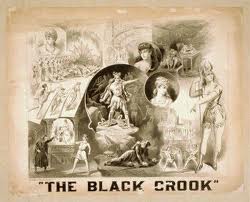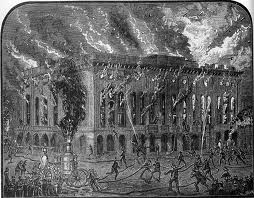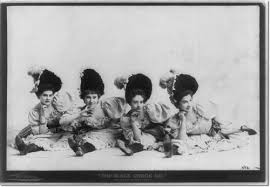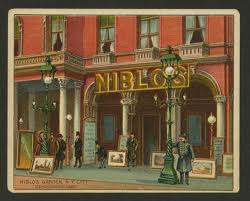For quite some time The Black Crook was known for two things- being the first musical and being the first long run play in NY. But now it’s known as the first long run play. Historians no longer considered it to have been a musical. It was a phenomenal mix of play, dance, music and spectacle that became the rage when it premiered at Niblo’s Garden on September 12, 1866. The Black Crook was extremely popular with the public for numerous reasons.
The Greeks Called it Tyche
It was pure chance, or as the Greeks called it tyche, that brought The Black Crook in its final form to the stage. The Black Crook was at first simply a melodrama by Charles M. Barras that retold the Faust story and borrowed liberally from other plays with similar plots and themes. William Wheatley, who was the manager of Niblo’s. was concerned that the play would fail. The script was poorly written and the acting wasn’t much better. But then something oddly magical happened.
There was a theatre fire at the Academy of Music in New York. A French ballet troupe was booked into the venue to present La Biche au Bois. But when the theatre burned down the 100-woman dance company had nowhere to perform. The managers of the Academy of Music, Henry C. Jarrett and Henry Palmer, had a ballet troupe from France and no place to put them.
Wheatley desperately needed something to spice up the play and Jarrett and Palmer needed to do something with the ballet company. Thus, the dancers were added to the show in order to create spectacle in the hope that audiences would be entertained. Much to the delight of the producers, they were!
However, playwright Barras objected to having his play cheapened by the addition of scantily clad dancers. After Wheatley offered him a $1,500 bonus, the writer no longer had a problem with the addition of 100 female dancers to his show.
What People Loved
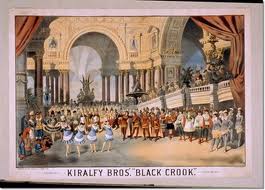
A later production of The Black Crook as produced by the Kiralfy Brothers who specialized in spectacle.
The Black Crook featured some spectacular dance numbers and special effects. This included an aerial ballet where the dancers were flown on wires and a descent into hell unlike any other. Although the show ran for more than five hours opening night, the amazing scenography, 100 dancers and 200 shapely legs made it a smash hit.
On September 17, the New York Tribune offered a review of opening night. In part it read:
“A vast grotto is herein presented, extending into an almost measureless perspective. Stalactites extend from the arched roof. A tranquil and lovely lake reflects the golden glories that span it like a vast sky. In every direction one sees the bright sheen or dull richness of massy gold. Beautiful fairies herein are assembled- the sprites of the ballet, who make the scene luxuriant with their beauty. “
Imaginative, creative, sexy and spectacular- The Black Crook was New York’s “must see” show.
Long Popular
Wheatley claimed to have produced The Black Crook for $25,000. In those days, that was a huge and unheard of amount of money for any play. But over the next decade or so The Black Crook, through its 474 performance run, numerous road companies and Broadway revivals would make millions.
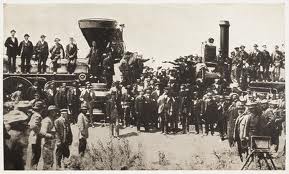
Although the first transcontinental railroad was not completed until 1869 by 1866 shows could easily tour to the populated areas of the Midwest.
The show was certainly helped by some recent developments. After the Civil War, women became a more active part of daily life. Many had worked in hospitals and run businesses during the war and the social strictures that kept them at home were loosened. That meant that there was a new audience for shows. Also, New York’s
population was swelling at this time and those growing numbers wanted entertainment. Finally, the rail system throughout the country quickly developed, making touring opportunities for large shows plentiful throughout the U.S. The Black Crook took advantage of all of these changes.
The Black Crook Was NOT a Musical
You’ll find various sources that used to claim and some that still claim that The Black Crook was the first musical or that it was the prototype for the American musical. But if you compare elements in The Black Crook to those in opera or operetta or burlesque, you find that each of these genres has the same basic elements as The Black Crook.
The Black Crook was a play that had dance numbers and songs interpolated throughout. But in no way were the elements unified- the songs were not specifically written for the play and the dances were more or less there to create interest in a show that was so poorly written that the producers knew it would flop. The Black Crook is no more a musical or the prototype for one than a ballad opera or the other three genres noted above.
What was The Black Crook? I’d say it was closer to an extravaganza than a musical. The extravaganza was a literary, musical, or theatre piece with music that included spectacular scenes, various types and styles of entertainment, such as burlesque, vaudeville, pantomime, etc., and a loose structure. The different elements in an extravaganza are not unified stylistically, thematically or in terms of plot. This is the case with The Black Crook. If the elements were united and the musical and dance numbers were fully integrated with the book, then the show would be considered a musical.
The Black Crook- New York’s first smash hit show. But not a musical.

